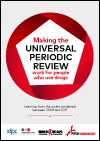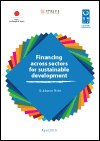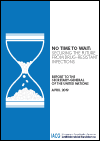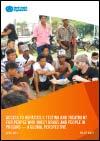What's New
Displaying results 1171 - 1180 of 4913

Resource | Guidelines,
This leaflet informs health providers about the do’s and don’ts in service provision to adolescents and young people living with HIV. The leaflet was developed by and with young people living with HIV. It includes experience illustration, a charter for health facilities that offer friendly services and a scorecard that can be used to assess the quality of services provided to adolescents and young people living with HIV.

Resource | Fact Sheets,
Girls Not Brides are calling on G7 countries to prioritise and act on child marriage. These advocacy briefs call on leaders in G7 countries to recognise the need for global level action on child marriage, to develop concrete solutions that are applied at the local level, and to pledge funding to support the implementation of policies and programmes to empower girls.
We are also showcasing the Southern African Development Community Model Model Law on Child Marriage as an example of best-practice gender equality legislation, calling on the G7 Gender Equality Advisory Council to include it within their legislative package, and to encourage the uptake of strong laws on child marriage.

Resource | Publications,
This report is intended as an advocacy tool to both celebrate the achievements of the past three decades and generate dialogue on the critical work that remains – especially for children who have been left behind. Based on the latest available data, the report outlines a selected set of issues that need urgent attention. It also advocates for all stakeholders to recommit to the Convention, stepping up their efforts to fulfil its promise in the next 30 years. Where there is political will and determination, the report concludes, children’s lives and well-being will improve.

Resource | Publications,
The Universal Periodic Review (UPR), alongside other international and national human rights mechanisms, is an important tool for holding countries that are part of the United Nations, known as UN Member States, accountable for respecting, promoting and fulfilling the human rights of people who use drugs, as well as fulfilling the pledges countries have made through the Sustainable Development Goals (SDGs). The UPR has the potential to improve human rights everywhere, for everyone. Countries can use it to initiate national human rights processes, and it can provide a valuable opportunity for civil society to engage governments on issues relating to human rights in the context of drug policies and people who use drugs.

Resource | Publications,
In 2017, key populations (KP) and their sexual partners accounted for approximately 40% of new HIV infections globally (UNAIDS, 2018). A range of policy and legal barriers and harmful social dynamics increase the HIV vulnerability of KP and undermine their access to HIV and other services. The criminalization of sex between men, sex work, drug use and HIV transmission, as well as high rates of incarceration, homophobia, trans phobia, violence and social marginalization, all serve to influence risk practices and undermine access to services. People from key populations often migrate to cities in search of safer and more secure communities (UNAIDS, UN Habitat 2015). Women in key populations face specific challenges and barriers, including gender-based violence (GBV) and poorly tailored services. These factors further intensify their vulnerability to HIV.

Resource | Publications,
This guidance note builds on UNDP’s Strategic Plan 2018–2021 which recognizes UNDP as an integrator to support “greater collaboration across sectors and partners to deliver impacts at scale and to utilize limited resources efficiently.” The guidance note also build on UNDP’s HIV, Health and Development Strategy 2016–2021 which stresses the need for “innovative approaches that harness synergies across the goals […] particularly given the need to make the most efficient and effective use of available development resources."

Resource | Publications,
The 2016 Political Declaration of the High-level Meeting of the United Nations General Assembly on Antimicrobial Resistance represented a landmark in the world’s commitment to tackling antimicrobial resistance, calling for greater urgency and action in response to its many challenges. In the political declaration, Member States requested the Secretary-General, in consultation with the Food and Agriculture Organization of the United Nations (FAO), the World Organisation for Animal Health (OIE) and the World Health Organization (WHO) to convene an ad hoc interagency coordination group (IACG) co-chaired by the Executive Office of the Secretary-General and the Director-General of WHO to provide practical guidance for approaches needed to ensure sustained, effective global action to address antimicrobial resistance. It also requested the Secretary-General to submit a report for consideration by Member States by the seventy-third session of the General Assembly in 2019 on the implementation of the political declaration and on further developments and recommendations emanating from the IACG, including on options to improve coordination, considering the 2015 Global Action Plan on Antimicrobial Resistance.
This report presents the IACG’s response to the request from Member States in the 2016 political declaration and makes recommendations for urgent action for consideration by the Secretary-General, Member States and other stakeholders in the global response to antimicrobial resistance.

Resource | Publications,
WHO estimates that 71 million people worldwide were chronically infected with hepatitis C virus (HCV) in 2017. Globally, 23% of new HCV infections and one in three HCV deaths are attributable to injecting drug use (PWID). HCV is also a major concern for people detained in prisons and other closed settings – available data demonstrate that one in four detainees are HCV positive.
This policy brief highlights the current landscape of country hepatitis policies for harm reduction and HCV testing and treatment in PWID and people in prisons. It aims to capture how governments are translating the WHO Global health sector strategy on viral hepatitis, 2016-2021 into national plans, and provides a summary of the enablers and barriers to HCV testing and treatment in these populations.

Resource | Publications,
The world drug problem has multiple public health dimensions encompassing vulnerability to drug use disorders and dependence, treatment and care of people with drug use disorders, reducing harm associated with drug misuse, and access to controlled medicines for medical pain relief.
In partnership with the UN Office on Drugs and Crime (UNODC), which is recognized as the leading UN entity for countering the world drug problem, the World Health Organization (WHO) has a pivotal and unique role in addressing the public health and human rights dimensions of global issues related to drugs.

Resource | Publications,
Reproductive rights and choices have become a reality for more women than ever. But we cannot be complacent: rights are still out of reach for too many women. Our challenge is to finish the unfinished business of guaranteeing rights and choices for all. Read our latest State of the World Population report 2019, published in a year that marks the 50th anniversary of UNFPA's founding and the 25th anniversary of the revolutionary Programme of Action forged at the International Conference on Population and Development in Cairo.





